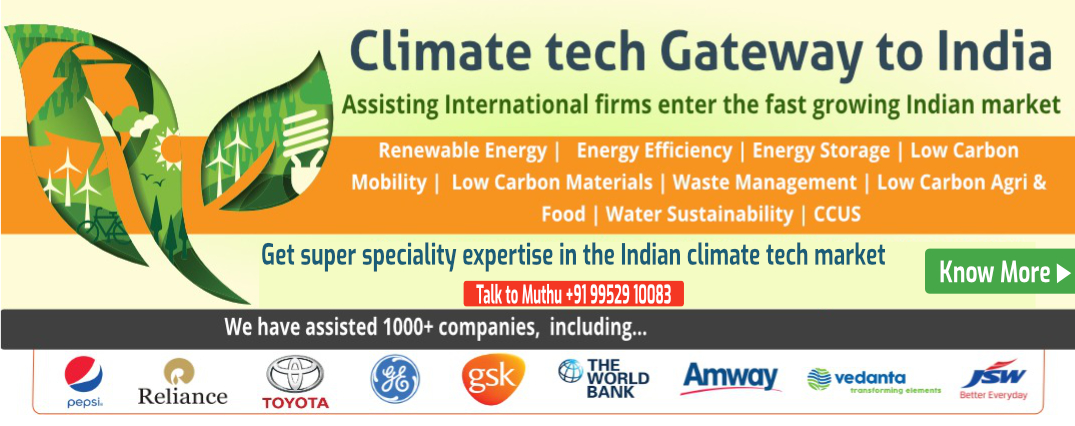This post is a part of Climate G2I Intelligence series from Energy Alternatives India (EAI), India’s leading climate-tech consulting firm.
G2I stands for Gateway 2 India, and provides comprehensive market intelligence and go-to market assistance for International firms entering the Indian climate-tech market. More about Climate G2I from here
In a significant development for India’s clean energy sector, NTPC, India’s largest energy conglomerate, and Siemens have signed a Memorandum of Understanding (MoU) to study the feasibility of hydrogen co-firing in gas turbines. This collaboration has the potential to play a crucial role in India’s decarbonization efforts by reducing CO2 emissions from the power sector.
NTPC is a state-owned enterprise and a major force in India’s energy landscape. It plays a crucial role in driving the country’s transition to cleaner energy sources. Siemens, on the other hand, brings its technological expertise in gas turbines and its deep understanding of energy systems, with vast experience in implementing hydrogen-related solutions across the globe.
The Indian power sector is undergoing a significant transformation, driven by the need to reduce carbon emissions and meet the country’s growing energy demand. It is the world’s third-largest energy consumer and faces a dual challenge of rising energy demand and the need to tackle severe air pollution. The government’s ambitious targets for renewable energy (450 GW by 2030), reduction in emissions intensity, and a dedicated National Hydrogen Mission signal its commitment to a clean energy future. Hydrogen co-firing in gas turbines is a promising technology that can help achieve these goals. By blending hydrogen with natural gas, power plants can reduce their CO2 emissions without compromising on efficiency.
Net Zero by Narsi
Insights and interactions on climate action by Narasimhan Santhanam, Director - EAI
View full playlistIt is important to note that NTPC is not only exploring hydrogen co-firing but also various other new hydrogen generation technologies. This comprehensive approach positions NTPC as a leader in India’s clean energy transition.
While the MoU between NTPC and Siemens is a prominent development, they are not the only players in India’s hydrogen co-firing landscape. Other major power companies, including Tata Power, Reliance Industries, and Adani Group, are actively exploring hydrogen solutions. Green hydrogen producers backed by renewable energy sources are expected to play a significant role in supplying this clean fuel. Government bodies like the Ministry of Power, MNRE, and think tanks like NITI Aayog are actively facilitating policy initiatives and driving the development of this sector.
Scaling up hydrogen co-firing presents challenges: the higher production costs of hydrogen compared to natural gas, building out hydrogen infrastructure, and ensuring the technical feasibility of combusting hydrogen blends in existing turbines. However, the potential benefits are significant: reducing emissions, utilizing existing gas infrastructure, and positioning India as a leader in clean energy innovation.
The Indian government’s strong commitment to a clean energy future acts as a major driver for the adoption of hydrogen co-firing technologies. Policy initiatives like the National Hydrogen Mission, incentives for green hydrogen production, and potential carbon pricing mechanisms can further accelerate the growth of the sector. The fall in renewable energy costs over the past decade has been a major contributor to making green hydrogen more economically viable, enhancing its potential as a co-firing fuel.
While India’s hydrogen co-firing sector is in its early stages, the potential for indigenization is vast. The “Make in India” initiative could incentivize domestic manufacturing of gas turbine components suitable for co-firing. Growing research capabilities in Indian universities and institutions can also lead to the development of indigenous technologies in this space.
This post is a part of Climate G2I Intelligence series from Energy Alternatives India (EAI), India’s leading climate-tech consulting firm.
G2I stands for Gateway 2 India, and provides comprehensive market intelligence and go-to market assistance for International firms entering the Indian climate-tech market. More about Climate G2I from here





 Our specialty focus areas include
Our specialty focus areas include



